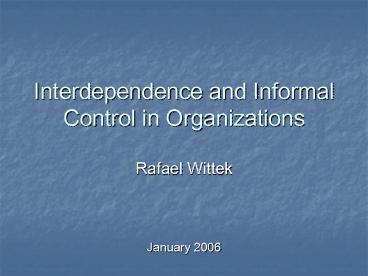Interdependence and Informal Control in Organizations - PowerPoint PPT Presentation
1 / 49
Title:
Interdependence and Informal Control in Organizations
Description:
Vignette Study. Rafael Wittek. UDC Geary Lecture, 17.1.2006. 14. Social Control in a Paper Factory ... stacked observations: 19 respondents, 8 vignettes, 12 ... – PowerPoint PPT presentation
Number of Views:72
Avg rating:3.0/5.0
Title: Interdependence and Informal Control in Organizations
1
Interdependence and Informal Control in
Organizations
- Rafael Wittek
- January 2006
2
(No Transcript)
3
- Effective social control requires unambiguous
relational signals.
4
Program
- Case Study A German Paper Factory
- Analytical Framework Relational Signaling Theory
- Empirical Evidence
- Conclusion
5
Case StudyA German Paper Factory
6
The Setting
7
(No Transcript)
8
Research Site
9
(No Transcript)
10
Organizational Context
- Paper Factory in Southern Germany
- Medium size firm, 180 employees
- Bought by multinational after bankrupcy in 1993
11
Organizational Context
- Extended Management Team
- 20 experienced paper engineers
- most team members work together for 10-20 years
- Strong ingroup identity
- Changes in hierarchical structure
12
Organizational Context
- Project
- Construction of a new production hall, deadline
1.9.1995 - Move of third paper machine from closed plant in
Munich - Integrate new colleagues into the team
- Highly visible within industry, high stakes
13
Research Design
- Participant observation
- Trouble case method
- Organizational context
- Sociometric panel study
- Trust relations
- Triad census
- Vignette Study
14
Social Control in a Paper Factory
n 67 trouble cases
15
Escalation of Social Control
- Social Escalation increasing number of actors
involved in social control process - Passive (unilateral) Avoidance
- Direct (bilateral) Peer pressure
- Indirect (trilateral, horizontal) Gossip
- Formal (trilateral, vertical) Snitching
- Public (multilateral) Trial
16
The Puzzle
- Why is there so much variation in control
behavior through time? - What caused informal control to break down in
1996?
17
Analytical FrameworkRelational Signaling Theory
18
Relational Signaling
- Individuals strive for social well-being
- E.g. Paper engineers professional prestige
- Social relations essential for production of
well-being - E.g. respect paid by colleagues
- Relational signals key for creation and
maintenance of social relationships - Positive signals indicate willingness to
maintain mutually rewarding social relation - Strong solidarity signals primacy of group over
bilateral relation and gain seeking - Weak solidarity signals primacy of gain seeking
tempered by concern for maintenance of bilateral
relation - Negative signals indicate disinterest in
maintaining relation, or attemt to harm social
well-being of ego - Ambiguous signalsdegree of alters interest in
maintaining mutually rewarding relation unclear - Source a.o.
- Lindenberg, S. 1998. Solidarity Its
Microfoundations and Macrodependence. In
Doreian, P. and Fararo, T. The Problem of
Solidarity. Gordon and Breach.
19
Types of Interdependence
- Unambiguous relational signals require alignment
between three types of interdependence - Functional Interdependence
- Common goal, tasks, division of labor
- Structural Interdependence
- Social relation in dyad is affected by or affects
relation to third parties - Cognitive Interdependence
- Shared beliefs, vaues
- Source
- Lindenberg, S. 1997. Grounding Groups in
Theory. Advances in Group Processes 14
20
Descriptive pirical Evidence
21
Functional Interdependence
22
(No Transcript)
23
(No Transcript)
24
Changes in Formal Structure
Task Interdependence
1997
-
Outcome Interde-pendence
1996
1995
25
Structural Interdependence
26
(No Transcript)
27
Changes in Informal Structure
28
Cognitive Interdependence
29
(No Transcript)
30
(No Transcript)
31
(No Transcript)
32
Changes in Formal and Informal Interdependence
Summary
33
Changes in Formal Interdependence
34
Changes in Informal Interdependence
35
Empirical Evidence Effects of (Changes in)
Formal and Informal Interdependence on Social
Escalation
36
Summary of Hypotheses
- Functional Interdependence
- Grievance severity increases escalation
- Structural Interdependence
- Personal ties decrease escalation
- Network embeddedness increases escalation
- Cognitive Interdependence
- Decay of solidarity frame increases escalation
37
Effects of Functional Interdependence
- Strong, repeated grievances elicit highest level
of social escalation - Based on vignette study (n1824 stacked
observations 19 respondents, 8 vignettes, 12
control strategies)
Effects of Grievance Severity and Frequency on
Escalation
38
Effects of Structural Interdependenceon Social
Escalation
39
Measurement of Structural Interdependence
- Triad census
- number of trust relationships
- Number of coalition triads
- Informal power advantage in trust network
40
Structural Embeddedness
Hole
Closure
Positive tie
Negative tie
41
Power Advantage Alter
Power Advantage Ego
42
Structural Interdependence and Social Escalation
Results
- The more strong ties an individual has, the
higher the level of social escalation - The higher the number of informal coalitions an
individual is embedded in, the higher the level
of escalation - Based on Trouble Case Analysis, n67 trouble
cases
43
Effects of Cognitive Interdependenceon Social
Escalation
44
Measurement of Cognitive Interdependence
- Number of Frame Stabilizing Activities
Frequency and inclusiveness of Meetings (MT,
Department, Project) - High in 1995
- Intermediate in 1996
- Low in 1997
45
Effects of Changing Interdependencies Results
- Effect of coalitions and strong ties on social
escalation disappears through time - Decay of solidarity frame through time increases
escalation
46
(No Transcript)
47
Summary of Hypotheses
Solidarity Hypothesis
Destabilization Hypotheses
Decreasing frame stabilizing activities
Frame Decay Hypothesis
Informal power advantage
Informal power hypothesis
negative effect
48
Summary
- Social control as social escalation
- Group processes driven by three types of
interdependence - Cognitive interdependence crucial moderator of
the effect of functional and structural
interdependence - frame decay results in sanctions becoming
ambiguous relational signals - (de)escalating effect of ties and networks
decreases over time
49
Conclusion
- Effective de-escalating informal control rests on
unambiguous relational signals - Relational signaling requires
- Solidarity frame stabilizing activities
- Balance of informal power
- Network of personal ties































